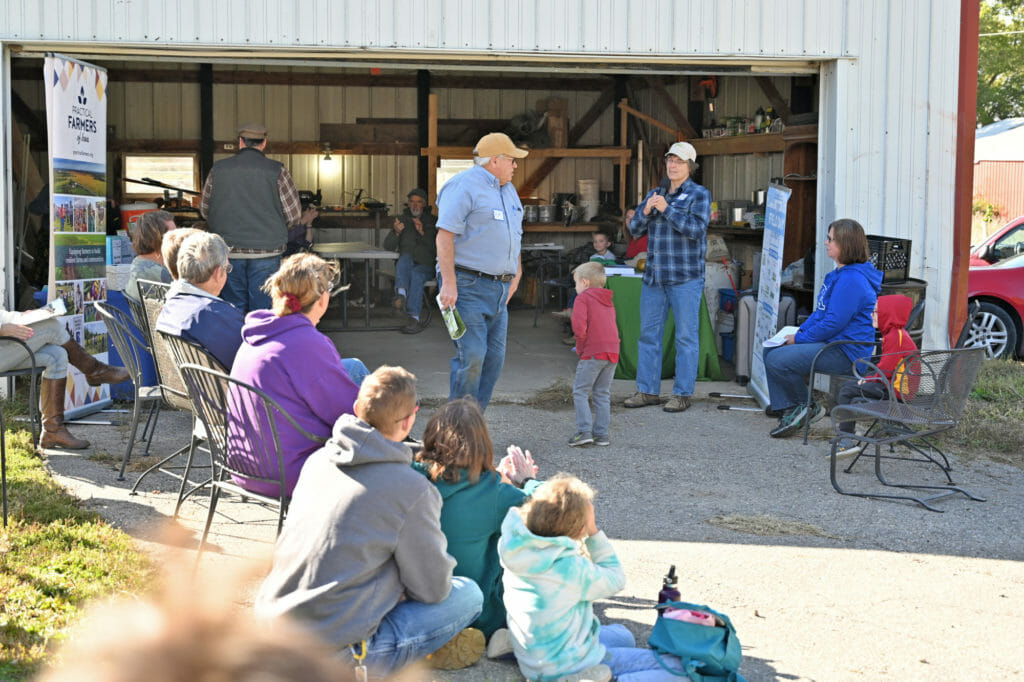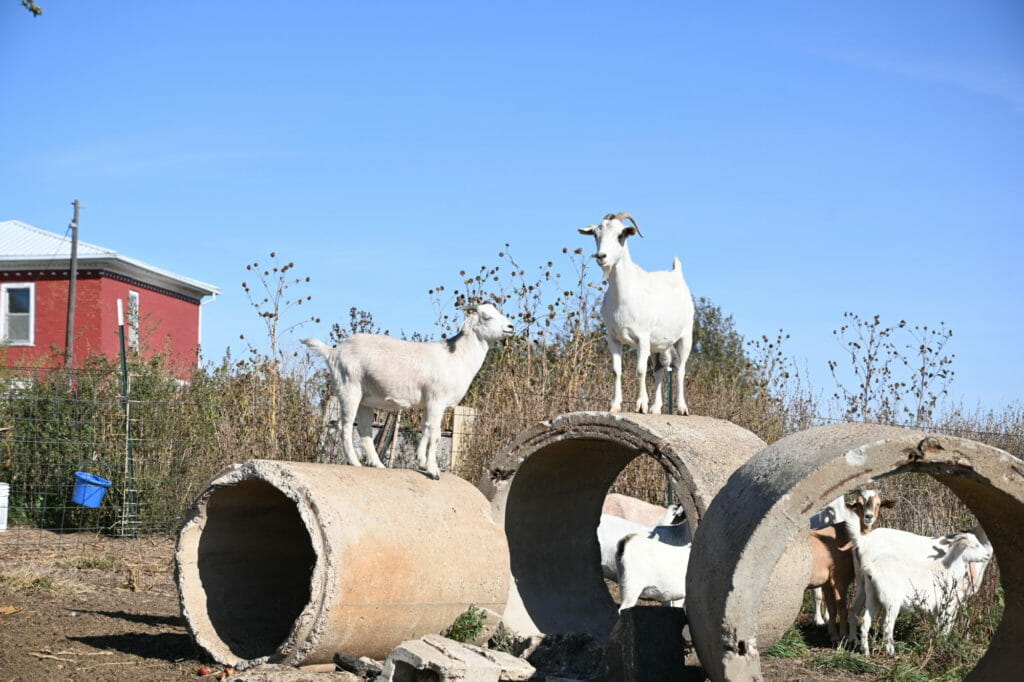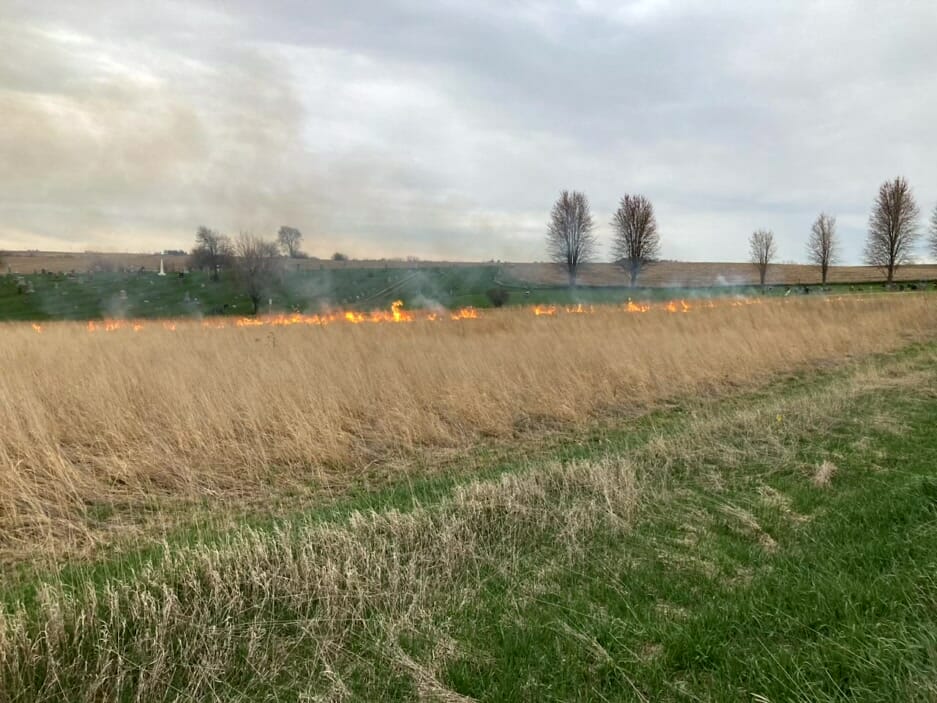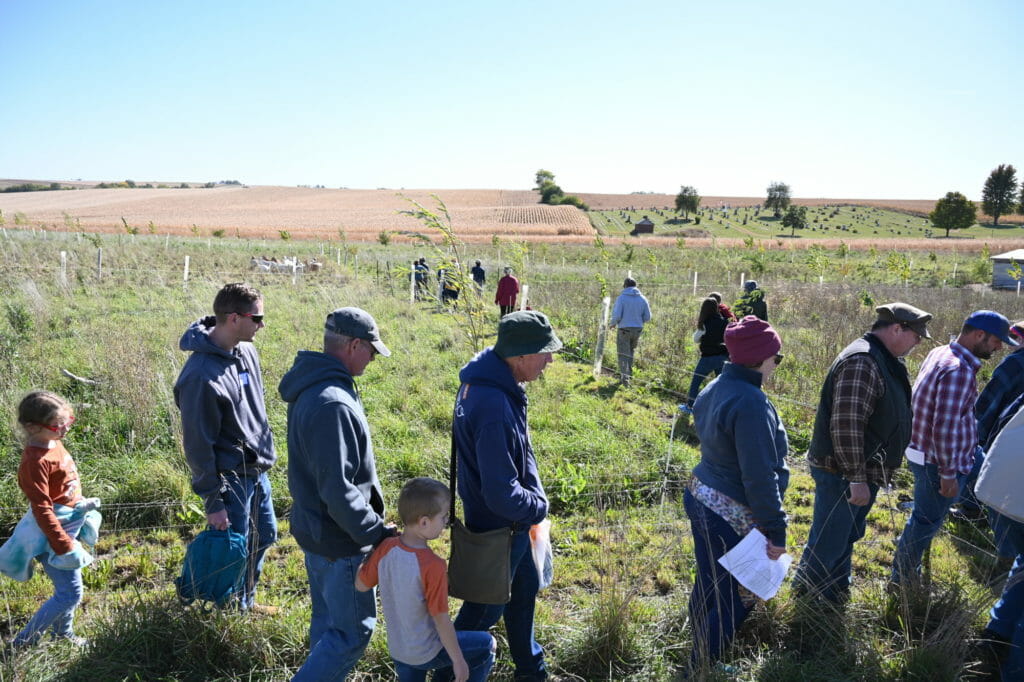Planting for the Future
Tim Swinton’s 11-acre farm just outside Clemons, Iowa, is surrounded by rolling fields of corn and soybeans. To the north a short ways, Middle Minerva Creek cuts through this patchwork of crop fields, flanked by the dappled green of trees growing along its banks. Just northeast of town, the creek joins South Minerva Creek, forming a triangle of trees before the conjoined waterway winds south and west of town in a sinuous green loop.
Viewed from above, the streams look like verdant veins snaking across the landscape. When Tim’s vision comes to fruition, his hope is that his farm will add to this arboreal mosaic. Since purchasing the land in 2018, Tim has been working to convert the former row crop acres into a diverse silvopasture system with a range of fruit and nut trees, shrubs and prairie plants integrated with pasture and goats.
“I wanted to move beyond the corn and soybean bubble,” says Tim, who also practices family medicine and describes himself as “an Iowa boy looking into the future.”

Growing Food in Iowa
Tim has been raising goats since 2003, keeping them on a friend’s farm. When he found his current farm site – which also includes a historic house built in 1856 that was once a roadside inn and stagecoach stop – he chose it intentionally, knowing he had other plans for the corn and soybean fields.
Since then, Tim has worked steadily to plant a variety of tree and shrub species, like chestnut, apple, pear, honeyberry, black currant and oak. He has also established prairie buffers, seeded over 20 pasture species, adopted rotational grazing and worked with Sustainable Iowa Land Trust’s landowner consultations to explore his farm’s potential.
“They [the goats] are very specific about what they want to eat and when, so we give them a choice.”
– Tim Swinton
Last October, he hosted a PFI field day to share his vision, showcase his newly planted trees and shrubs and lead guests on a tour of the property, which included meeting his playful Kiko goat herd. The event was co-hosted by SILT, which has partnered with the Natural Resources Conservation Service on a five-year grant to offer Iowa landowners free consultations to explore their farm’s potential for food production.
SILT cofounder Suzan Erem says the program is designed to help remind landowners that table food can be grown in Iowa. “Iowa imports over 90% of its food,” says Suzan, who retired earlier this year as SILT’s executive director. “So many landowners had forgotten they could grow table food, thinking that building [for development] and commodities are the only choices.”
Through the partnership with NRCS, Suzan says SILT is working to reverse that startling statistic. Landowners who sign up for the consultations go on a land walk with a SILT employee intensively trained to assess a land’s potential, and they receive a report outlining those opportunities. Suzan stresses that the land walk and report are not meant to teach landowners how to farm, but rather to inspire them to think about how they could use land in a different way.
“Tim had the capacity and the passion to make that change. It’s very exciting to see,” Suzan says. “A lot of landowners are in a place in their lives where their perspective is different – more financially secure, a higher tolerance for risk. That puts them in a position where they can attempt new things.”
Creating a Resilient Ecosystem
Tim’s vision for his land starts with the understanding that a biodiverse ecosystem is more resilient. He also recognizes the importance of stacking enterprises on a small land base. Tim’s goats graze rotationally on the silvopasture, which is pasture that incorporates trees. He has planted 22 species of trees and shrubs every 12 feet in several of his pastures. In others, he has planted prairie that can be burned.
“My dad says you don’t really pick a tree for your property, it picks you,” Tim says. “So much of what I’m doing is to see what thrives in my soil conditions.”
He adds: “Silvopasture is really about creating an ecosystem that complements itself in a flourishing, multidirectional sphere, like an orchestra. A diversity of trees encourages diversity in microbiology, birds, wildlife and goat diet choices.”
Tim explains how doubling up on enterprises is particularly beneficial if you have limited land. He also notes how using trees in pastures saves moisture, provides shade and can extend the grazing season. “The grazing season may be increased by a week or two in the spring and fall because of protection from harsh weather,” he says.
He also cuts branches from some of the trees to provide additional forage. Once the trees mature, Tim’s goats will also have the nuts from oak, pecan and chestnuts to munch on, as well as the pods from other trees like honey locust and catalpa. “Mulberry is candy to goats,” he says. “There are a lot of ways to make tree forages extend your pasture life.”
“A diversity of trees encourages diversity in microbiology, birds, wildlife and goat diet choices.”
– Tim Swinton
Tim has also experimented with a mix of grasses on low and high ground, identifying which survived on eroded ground or in wetter pastures. Chicory, he explains, thrives on compacted and eroded hillsides. “Its deep tap root reaches down so it instantly comes back,” he says. The diversity of plants in his pastures also lets his goats self-select what they need to support their health.
“One of my favorite wild plants is wild lettuce,” Tim says. “The goats go right for it even when it’s fuzzy – they eat the fuzzy heads off. They are very specific about what they want to eat and when, so we give them a choice.”

Suzan Erem of SILT (blue plaid shirt) speaks to the crowd with Tim Swinton at his field day in October 2022.
Continually testing his system, Tim regularly tries new strategies to see what may help his goats, including using kelp as a supplement, trying sprouted barley and offering new species like sweet yellow clover or African cabbage. Beyond this focus on plant diversity, Tim actively manages his goat herd. He intensively selects breeding stock and diligently culls a high percentage of his herd each year to be sure he is developing a herd with hardy and resistant genetics. His goal to is select animals with robust parasite resistance and strong mothering instincts who also thrive in his silvopasture system.
Farming for the Next Generation
Tim recognizes his farm is in the early stages of a long-term project. He imagines the possibility years from now when his trees and shrubs have all matured and are bearing fruit, and what healthier soil will mean for each species. He also thinks about what others can learn from his farm and how it can serve as a model.
“Sometimes, someone in the neighborhood just has to go first,” Tim says. “One neighbor gets a chuckle about what I’m doing in rural Iowa because culture, the ideas really have to prove themselves over time.”
Tim advises other landowners thinking of making changes to first consider their resources – like how much time they have and what kinds of equipment. He also emphasizes the need for patience. “It takes about five years to get your soil back,” he says. “And every year my pasture changes.”
Tim has found that rotating pastures in the spring or later in the summer can change what grows from year to year. In dryer years, he’s noticed that warm-season grasses are likely to flourish. What grows can also change based on how much rest his pastures get and how long between rotations. “It’s a moving target what you keep in your pasture,” he says.
As Suzan reflects on her retirement from SILT, she describes the power landowners like Tim have to make changes on the Iowa landscape. “It’s a legacy for those who don’t see land as a commodity,” she says. “They see that land gives us life.”
Tim is certainly one of those people. “We have had such a pioneering spirit,” he says, referring to past generations in Iowa who once produced a diversity of crops and livestock on the land and grew most of their own food. “I’m looking for innovations that are going to help the next generations of farmers.”




